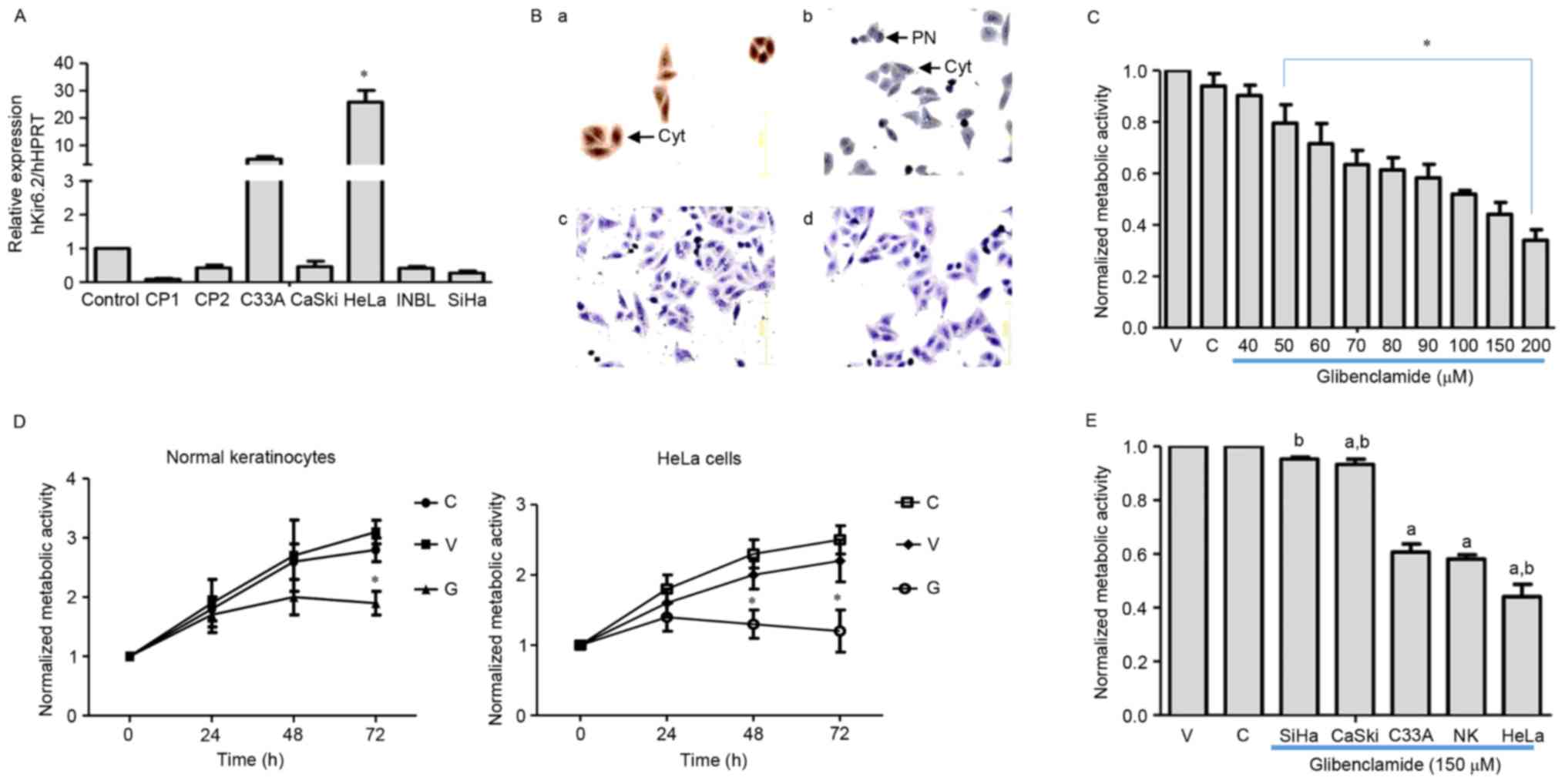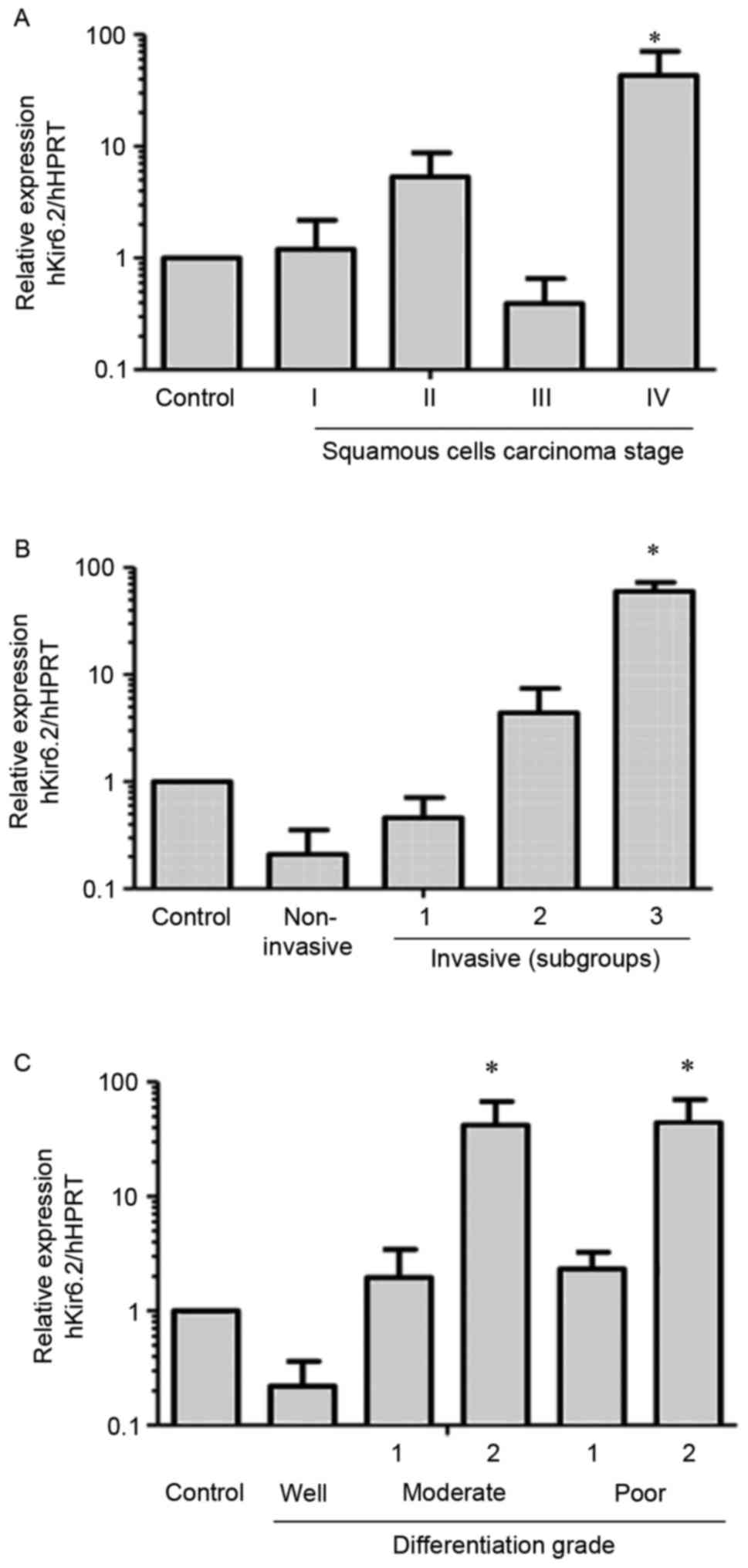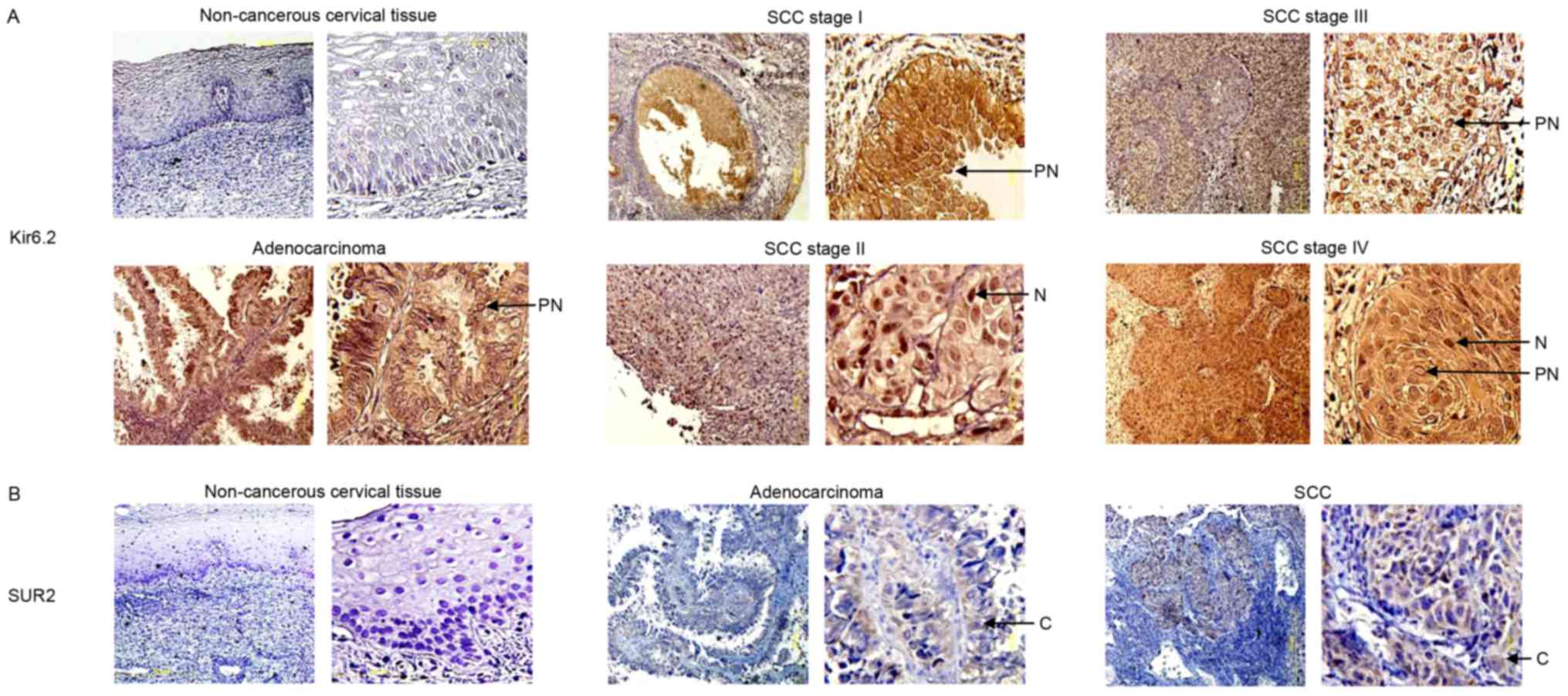|
1
|
Ferlay J, Soerjomataram I, Dikshit R, Eser
S, Mathers C, Rebelo M, Parkin DM, Forman D and Bray F: Cancer
incidence and mortality worldwide: Sources, methods and major
patterns in GLOBOCAN 2012. Int J Cancer. 136:E359–E386. 2015.
View Article : Google Scholar : PubMed/NCBI
|
|
2
|
Moore DH: Cervical cancer. Obstet Gynecol.
107:1152–1161. 2006. View Article : Google Scholar : PubMed/NCBI
|
|
3
|
Cadron I, Van Gorp T, Amant F, Leunen K,
Neven P and Vergote I: Chemotherapy for recurrent cervical cancer.
Gynecol Oncol. 107 1 Suppl 1:S113–S118. 2007. View Article : Google Scholar : PubMed/NCBI
|
|
4
|
Dubois JM and Rouzaire-Dubois B: Role of
potassium channels in mitogenesis. Prog Biophys Mol Biol. 59:1–21.
1993. View Article : Google Scholar : PubMed/NCBI
|
|
5
|
Pardo LA and Stühmer W: The roles of K(+)
channels in cancer. Nat Rev Cancer. 14:39–48. 2014. View Article : Google Scholar : PubMed/NCBI
|
|
6
|
Clement JP IV, Kunjilwar K, Gonzalez G,
Schwanstecher M, Panten U, Aguilar-Bryan L and Bryan J: Association
and stoichiometry of K(ATP) channel subunits. Neuron. 18:827–838.
1997. View Article : Google Scholar : PubMed/NCBI
|
|
7
|
Babenko AP, Aguilar-Bryan L and Bryan J: A
view of sur/KIR6.X, KATP channels. Annu Rev Physiol. 60:667–687.
1998. View Article : Google Scholar : PubMed/NCBI
|
|
8
|
Inagaki N, Gonoi T, Clement JP, Wang CZ,
Aguilar-Bryan L, Bryan J and Seino S: A family of sulfonylurea
receptors determines the pharmacological properties of
ATP-sensitive K+ channels. Neuron. 16:1011–1017. 1996.
View Article : Google Scholar : PubMed/NCBI
|
|
9
|
Aguilar-Bryan L and Bryan J: Molecular
biology of adenosine triphosphate-sensitive potassium channels.
Endocr Rev. 20:101–135. 1999. View Article : Google Scholar : PubMed/NCBI
|
|
10
|
Aguilar-Bryan L, Nichols CG, Wechsler SW,
Clement JP IV, Boyd AE III, González G, Herrera-Sosa H, Nguy K,
Bryan J and Nelson DA: Cloning of the beta cell high-affinity
sulfonylurea receptor: A regulator of insulin secretion. Science.
268:423–426. 1995. View Article : Google Scholar : PubMed/NCBI
|
|
11
|
Noma A: ATP-regulated K+
channels in cardiac muscle. Nature. 305:147–148. 1983. View Article : Google Scholar : PubMed/NCBI
|
|
12
|
Quayle JM, Nelson MT and Standen NB:
ATP-sensitive and inwardly rectifying potassium channels in smooth
muscle. Physiol Rev. 77:1165–1232. 1997. View Article : Google Scholar : PubMed/NCBI
|
|
13
|
Sakura H, Ammälä C, Smith PA, Gribble FM
and Ashcroft FM: Cloning and functional expression of the cDNA
encoding a novel ATP-sensitive potassium channel subunit expressed
in pancreatic beta-cells, brain, heart and skeletal muscle. FEBS
Lett. 377:338–344. 1995. View Article : Google Scholar : PubMed/NCBI
|
|
14
|
Trube G, Rorsman P and Ohno-Shosaku T:
Opposite effects of tolbutamide and diazoxide on the ATP-dependent
K+ channel in mouse pancreatic beta-cells. Pflugers
Arch. 407:493–499. 1986. View Article : Google Scholar : PubMed/NCBI
|
|
15
|
Sturgess NC, Ashford ML, Cook DL and Hales
CN: The sulphonylurea receptor may be an ATP-sensitive potassium
channel. Lancet. 2:474–475. 1985. View Article : Google Scholar : PubMed/NCBI
|
|
16
|
Kasikcioglu HA and Cam N: A review of
levosimendan in the treatment of heart failure. Vasc Health Risk
Manag. 2:389–400. 2006. View Article : Google Scholar : PubMed/NCBI
|
|
17
|
Downey JM and Cohen MV: Do mitochondrial
KATP channels serve as triggers rather than end-effectors of
ischemic preconditioning's protection? Basic Res Cardiol.
95:272–274. 2000. View Article : Google Scholar : PubMed/NCBI
|
|
18
|
Malhi H, Irani AN, Rajvanshi P, Suadicani
SO, Spray DC, McDonald TV and Gupta S: KATP channels regulate
mitogenically induced proliferation in primary rat hepatocytes and
human liver cell lines. Implications for liver growth control and
potential therapeutic targeting. J Biol Chem. 275:26050–26057.
2000. View Article : Google Scholar : PubMed/NCBI
|
|
19
|
Monen SH, Schmidt PH and Wondergem R:
Membrane potassium channels and human bladder tumor cells. I.
Electrical properties. J Membr Biol. 161:247–256. 1998. View Article : Google Scholar : PubMed/NCBI
|
|
20
|
Qian X, Li J, Ding J, Wang Z, Duan L and
Hu G: Glibenclamide exerts an antitumor activity through reactive
oxygen species-c-jun NH2-terminal kinase pathway in human gastric
cancer cell line MGC-803. Biochem Pharmacol. 76:1705–1715. 2008.
View Article : Google Scholar : PubMed/NCBI
|
|
21
|
Huang L, Li B, Li W, Guo H and Zou F:
ATP-sensitive potassium channels control glioma cells proliferation
by regulating ERK activity. Carcinogenesis. 30:737–744. 2009.
View Article : Google Scholar : PubMed/NCBI
|
|
22
|
Wondergem R, Cregan M, Strickler L, Miller
R and Suttles J: Membrane potassium channels and human bladder
tumor cells: II. Growth properties. J Membr Biol. 161:257–262.
1998. View Article : Google Scholar : PubMed/NCBI
|
|
23
|
Abdul M and Hoosein N: Expression and
activity of potassium ion channels in human prostate cancer. Cancer
Lett. 186:99–105. 2002. View Article : Google Scholar : PubMed/NCBI
|
|
24
|
Farias LM, Ocaña DB, Díaz L, Larrea F,
Avila-Chávez E, Cadena A, Hinojosa LM, Lara G, Villanueva LA,
Vargas C, et al: Ether a go-go potassium channels as human cervical
cancer markers. Cancer Res. 64:6996–7001. 2004. View Article : Google Scholar : PubMed/NCBI
|
|
25
|
Pecorelli S: Revised FIGO staging for
carcinoma of the vulva, cervix, and endometrium. Int J Gynaecol
Obstet. 105:103–104. 2009. View Article : Google Scholar : PubMed/NCBI
|
|
26
|
Livak KJ and Schmittgen TD: Analysis of
relative gene expression data using real-time quantitative PCR and
the 2(-Delta Delta C(T)) method. Methods. 25:402–408. 2001.
View Article : Google Scholar : PubMed/NCBI
|
|
27
|
Payen L, Delugin L, Courtois A, Trinquart
Y, Guillouzo A and Fardel O: The sulphonylurea glibenclamide
inhibits multidrug resistance protein (MRP1) activity in human lung
cancer cells. Br J Pharmacol. 132:778–784. 2001. View Article : Google Scholar : PubMed/NCBI
|
|
28
|
Borst P, Evers R, Kool M and Wijnholds J:
The multidrug resistance protein family. Biochim Biophys Acta.
1461:347–357. 1999. View Article : Google Scholar : PubMed/NCBI
|
|
29
|
Lautier D, Canitrot Y, Deeley RG and Cole
SP: Multidrug resistance mediated by the multidrug resistance
protein (MRP) gene. Biochem Pharmacol. 52:967–977. 1996. View Article : Google Scholar : PubMed/NCBI
|
|
30
|
Sheppard DN and Robinson KA: Mechanism of
glibenclamide inhibition of cystic fibrosis transmembrane
conductance regulator Cl- channels expressed in a murine cell line.
J Physiol. 503:333–346. 1997. View Article : Google Scholar : PubMed/NCBI
|
|
31
|
Kim JA, Kang YS, Lee SH, Lee EH, Yoo BH
and Lee YS: Glibenclamide induces apoptosis through inhibition of
cystic fibrosis transmembrane conductance regulator (CFTR) Cl(-)
channels and intracellular Ca(2+) release in HepG2 human
hepatoblastoma cells. Biochem Biophys Res Commun. 261:682–688.
1999. View Article : Google Scholar : PubMed/NCBI
|
|
32
|
Sheppard DN and Welsh MJ: Effect of
ATP-sensitive K+ channel regulators on cystic fibrosis
transmembrane conductance regulator chloride currents. J Gen
Physiol. 100:573–591. 1992. View Article : Google Scholar : PubMed/NCBI
|
|
33
|
Gerloff T, Stieger B, Hagenbuch B, Madon
J, Landmann L, Roth J, Hofmann AF and Meier PJ: The sister of
P-glycoprotein represents the canalicular bile salt export pump of
mammalian liver. J Biol Chem. 273:10046–10050. 1998. View Article : Google Scholar : PubMed/NCBI
|
|
34
|
Stieger B, Fattinger K, Madon J,
Kullak-Ublick GA and Meier PJ: Drug- and estrogen-induced
cholestasis through inhibition of the hepatocellular bile salt
export pump (Bsep) of rat liver. Gastroenterology. 118:422–430.
2000. View Article : Google Scholar : PubMed/NCBI
|
|
35
|
Ambudkar SV, Dey S, Hrycyna CA,
Ramachandra M, Pastan I and Gottesman MM: Biochemical, cellular,
and pharmacological aspects of the multidrug transporter. Annu Rev
Pharmacol Toxicol. 39:361–398. 1999. View Article : Google Scholar : PubMed/NCBI
|
|
36
|
Golstein PE, Boom A, van Geffel J, Jacobs
P, Masereel B and Beauwens R: P-glycoprotein inhibition by
glibenclamide and related compounds. Pflugers Arch. 437:652–660.
1999. View Article : Google Scholar : PubMed/NCBI
|
|
37
|
Peng X, Wu Z, Yu L, Li J, Xu W, Chan HC,
Zhang Y and Hu L: Overexpression of cystic fibrosis transmembrane
conductance regulator (CFTR) is associated with human cervical
cancer malignancy, progression and prognosis. Gynecol Oncol.
125:470–476. 2012. View Article : Google Scholar : PubMed/NCBI
|
|
38
|
Núñez M, Medina V, Cricco G, Croci M,
Cocca C, Rivera E, Bergoc R and Martín G: Glibenclamide inhibits
cell growth by inducing G0/G1 arrest in the human breast cancer
cell line MDA-MB-231. BMC Pharmacol Toxicol. 14:62013. View Article : Google Scholar : PubMed/NCBI
|
|
39
|
Artym VV and Petty HR: Molecular proximity
of Kv1.3 voltage-gated potassium channels and beta(1)-integrins on
the plasma membrane of melanoma cells: Effects of cell adherence
and channel blockers. J Gen Physiol. 120:29–37. 2002. View Article : Google Scholar : PubMed/NCBI
|
|
40
|
Agarwal JR, Griesinger F, Stühmer W and
Pardo LA: The potassium channel Ether à go-go is a novel prognostic
factor with functional relevance in acute myeloid leukemia. Mol
Cancer. 9:182010. View Article : Google Scholar : PubMed/NCBI
|
|
41
|
Afrasiabi E, Hietamäki M, Viitanen T,
Sukumaran P, Bergelin N and Törnquist K: Expression and
significance of HERG (KCNH2) potassium channels in the regulation
of MDA-MB-435S melanoma cell proliferation and migration. Cell
Signal. 22:57–64. 2010. View Article : Google Scholar : PubMed/NCBI
|
|
42
|
Pillozzi S, Brizzi MF, Bernabei PA,
Bartolozzi B, Caporale R, Basile V, Boddi V, Pegoraro L, Becchetti
A and Arcangeli A: VEGFR-1 (FLT-1), beta1 integrin, and hERG
K+ channel for a macromolecular signaling complex in
acute myeloid leukemia: Role in cell migration and clinical
outcome. Blood. 110:1238–1250. 2007. View Article : Google Scholar : PubMed/NCBI
|
|
43
|
Cherubini A, Hofmann G, Pillozzi S, Guasti
L, Crociani O, Cilia E, Di Stefano P, Degani S, Balzi M, Olivotto
M, et al: Human ether-a-go-go-related gene 1 channels are
physically linked to beta1 integrins and modulate
adhesion-dependent signaling. Mol Biol Cell. 16:2972–2983. 2005.
View Article : Google Scholar : PubMed/NCBI
|
|
44
|
Lastraioli E, Guasti L, Crociani O,
Polvani S, Hofmann G, Witchel H, Bencini L, Calistri M, Messerini
L, Scatizzi M, et al: herg1 gene and HERG1 protein are
overexpressed in colorectal cancers and regulate cell invasion of
tumor cells. Cancer Res. 64:606–611. 2004. View Article : Google Scholar : PubMed/NCBI
|
|
45
|
Guo Z, Liu J, Zhang L, Su B, Xing Y, He Q,
Ci W, Li X and Zhou L: KCNJ1 inhibits tumor proliferation and
metastasis and is a prognostic factor in clear cell renal cell
carcinoma. Tumour Biol. 36:1251–1259. 2015. View Article : Google Scholar : PubMed/NCBI
|
|
46
|
Veeravalli KK, Ponnala S, Chetty C, Tsung
AJ, Gujrati M and Rao JS: Integrin α9β1-mediated cell migration in
glioblastoma via SSAT and Kir4.2 potassium channel pathway. Cell
Signal. 24:272–281. 2012. View Article : Google Scholar : PubMed/NCBI
|
|
47
|
Kraft R, Krause P, Jung S, Basrai D,
Liebmann L, Bolz J and Patt S: BK channel openers inhibit migration
of human glioma cells. Pflugers Arch. 446:248–255. 2003. View Article : Google Scholar : PubMed/NCBI
|
|
48
|
Weaver AK, Bomben VC and Sontheimer H:
Expression and function of calcium-activated potassium channels in
human glioma cells. Glia. 54:223–233. 2006. View Article : Google Scholar : PubMed/NCBI
|
|
49
|
Sciaccaluga M, Fioretti B, Catacuzzeno L,
Pagani F, Bertollini C, Rosito M, Catalano M, D'Alessandro G,
Santoro A, Cantore G, et al: CXCL12-induced glioblastoma cell
migration requires intermediate conductance
Ca2+-activated K+ channel activity. Am J
Physiol Cell Physiol. 299:C175–C184. 2010. View Article : Google Scholar : PubMed/NCBI
|
|
50
|
Cuddapah VA, Turner KL, Seifert S and
Sontheimer H: Bradykinin-induced chemotaxis of human gliomas
requires the activation of KCa3.1 and ClC-3. J Neurosci.
33:1427–1440. 2013. View Article : Google Scholar : PubMed/NCBI
|
|
51
|
Chantôme A, Potier-Cartereau M, Clarysse
L, Fromont G, Marionneau-Lambot S, Guéguinou M, Pagès JC, Collin C,
Oullier T, Girault A, et al: Pivotal role of the lipid Raft
SK3-Orai1 complex in human cancer cell migration and bone
metastases. Cancer Res. 73:4852–4861. 2013. View Article : Google Scholar : PubMed/NCBI
|
|
52
|
Liu X and Chang Y, Reinhart PH, Sontheimer
H and Chang Y: Cloning and characterization of glioma BK, a Novel
BK Channel isoform highly expressed in human glioma cells. J
Neurosci. 22:1840–1849. 2002. View Article : Google Scholar : PubMed/NCBI
|













